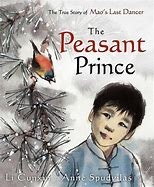Life in rural China in the 1960s was hard for a small boy and his large family. Though Li Cunxin’s family loved each other dearly there was rarely enough to eat and everything was owned and controlled by the government. One day, four government officials came to his school looking for children to study ballet. At the last moment the teacher pointed at Li Cunxin asking, ‘What about him?’ The officials measured and tested him and after many weeks the news came that Li Cunxin had been chosen from all the millions of children in China to leave home and become a dancer.
Li Cunxin’s best-selling autobiography ‘Mao’s Last Dancer’ was first published in 2003. In 2007, a picture book version ‘The Peasant Prince’ appeared with Li Cunxin’s text brought to life by Anne Spudvilas’ artwork. Anne Spudvilas travelled to China to research the book including visiting the Beijing Dance Academy that Li Cunxin attended, visited his family in the village of Qingdao, and studied Chinese art techniques.
The illustrations are in traditional Chinese ink and watercolour on rice paper, and oil paints on canvas. The colour palette is predominately muted blues, greys, and browns and there is a uniformity to the clothing that is in keeping with social and political culture in China in the 1960s. This is broken with the occasional brighter colour such as the candlelight when Li practices. This palette changes dramatically when Li travels to America. Then illustrations are infused with bright colours and light providing a strong contrast to life in China.
At the start of the book, we learn the story of the frog that lived in the well and tried desperately to escape but the frog’s father said, ‘It’s no use son I have tried all my life to get out.’ Li Cunxin remembers this story and knows that the little frog did get out of the well. He became a famous dancer but never forgot his family or that faraway village Qingdao.
‘The Peasant Prince’ has been made into a stage production, a symphonic tale and has won several Awards including –
Winner 2008 Queensland Premier’s Literary Awards
Winner 2008 Australian Book Industry Awards (ABIA) – Australian Book of the Year for Younger Children
Winner 2008 New South Wales Premier’s Literary Awards – Patricia Wrightson Prize for Children’s Books
Honour Book 2008 CBCA Book of the Year Awards – Picture Book of the Year
Shortlisted 2008 Australian Booksellers Association Awards – Booksellers Choice Award

